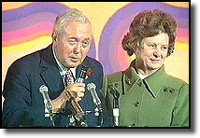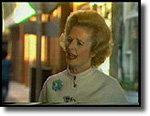
|
10 October 1974Labour Prime Minister Harold Wilson was forced to call the second general election of 1974 in a bid to turn his minority in Parliament into a solid working majority. He was up against Conservative leader Edward Heath once more and the opinion polls predicted a Labour victory. In the event Labour won, but only just. With a majority of only three seats there would be tough times ahead for Labour.
Background
Harold Wilson, now Prime Minister for the third time, successfully took action to end the miners' strike that had helped to bring Heath's government down. Labour attempted to work with the unions to end the perennial industrial disputes that had made Britain an unstable and divided nation, but it was clear that Wilson needed to call a second general election if the Government was to remain in office. Britain's continuing instability and the deterioration of living standards in comparison to the rest of Europe provided the backdrop for the election campaign. Inflation, which was climbing partly due to the Government's pay settlement with the miners, was high as were balance of trade deficits. The Labour Party, however, remained confident of victory, hoping that the country would give it longer than eight months to solve the nation's problems. Wilson also assumed that he could blame the previous Tory administration and the prevailing global economic trends for Britain's unhappy state. In September Wilson called the election for 10 October.
The October election contained more women candidates, more Liberals, more Welsh and Scottish nationalists and more National Front than ever before. Margaret Beckett and Bryan Gould were among those new members brought into the House on the back of Wilson's victory. The Labour share of the vote increased by 2%, the Tory vote dropped by the same amount. The Liberals made a strong showing of 18% but this was, disappointingly, 1% lower than in February. Labour had 42 seats more than the Tories and would be able to govern comfortably, at least for the moment.
|
Diana, Princess of Wales, 1961-1997
Conference 97
Devolution
The Archive
News |
Issues |
Background |
Parties |
Analysis |
TV/Radio/Web
Interactive |
Forum |
Live |
About This Site
News |
Issues |
Background |
Parties |
Analysis |
TV/Radio/Web
Interactive |
Forum |
Live |
About This Site
© BBC 1997 |
politics97@bbc.co.uk |

